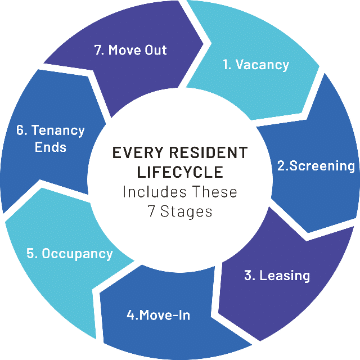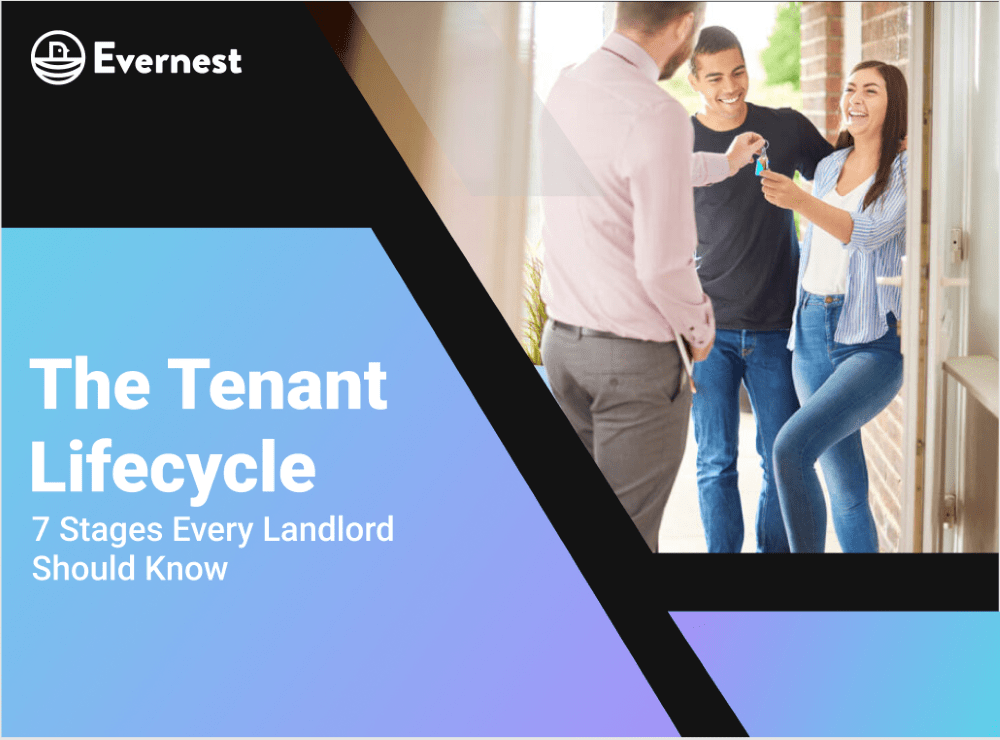The Resident Lifecycle: 7 Stages Every Landlord Should Know
Being a landlord is a walk in the park, right? Simply buy a property, maybe do some quick fixes, find a superstar resident, sign that lease agreement, and BAM! You have yourself a cash-flowing rental property. Unfortunately for most investors and landlords, this is purely wishful thinking.Whether you’re a homeowner looking to rent out your house, a first-time investor placing your first resident, or a seasoned vet expanding into new markets—property management is no joke. This is why those with the most success as a landlord understand two things very intimately:
- The resident lifecycle
- Necessary processes for managing their rental
In this article, you’ll learn the 7 stages of the resident lifecycle, how you can plan for your next resident, and the processes needed every step of the way. NOTE: To give you better insights into the processes and procedures necessary for each stage, this article features insights and quotes from a property management expert, Leslie Wilson, CAM®, a seasoned residential property manager with Evernest.
What is the Lifecycle of a Resident?

Here are the 7 stages of any resident’s lifecycle on your property:
1. Vacancy
Stage one starts with your property being empty. It’s critical that you start things off on the right foot and make sure your property is prepared to become someone’s new home. To do that, there are some things you should do:
- Clean the unit
- Take high-quality photos of the interior and exterior
- Handle any necessary repairs and maintenance issues (non-emergency repairs)
- Tackle tasks like sealing toilet bases, changing HVAC filters, checking smoke detectors, changing locks (if necessary), etc
Pro Tip Are you a new investor OR someone looking to deploy capital in less established neighborhoods? During this stage, it’s good to assess in-depth not only the state of your property but also any additional needs regarding utilities. The reason is if your property,
- Has been vacant for 1 year+
- Is in an unestablished/older neighborhood
—you may have major upfront costs to get basic utilities started. Think things like replacing utility meters altogether, putting in a new water main, etc.
2. Screening
During stage two, it’s time to start your screening process. Here’s what our screening process consists of to give you an idea of ways to thoroughly vet potential residents:“We are going to conduct a criminal background check and a full credit check. Underwriting will also complete a rental verification, which is pretty extensive, to ensure that there are no balances on the credit report that had anything to do with either an eviction or a collection's rental balance. They will also do a thorough rental verification if indeed any prior addresses are verified as rental addresses on the application.”Our four-step screening process includes:
- Credit check
- Criminal background
- Income verification (additional layer of protection)
- Rental verification
“The first thing that they'll do is the credit check. And if for any reason, applicants don't pass that, or if their income isn't sufficient, they don't proceed with anything else. But as long as they pass that first stage, then after that, they'll do the criminal background. Step three, we’ll do the income verification, which is an additional layer of protection for the owner, because they're going to not just accept copies of pay stubs or copies of a W-2, for example. They're going to actually call the employers, speak to the employers on the phone, as well as do some paperwork. This ensures that the employers confirm that there's no question about that person's employment status. The goal of this process is to make sure that we're vetting each prospect so that the owner has the least chance possible of getting someone in there that's not going to successfully pay and also making sure that we're not moving someone in that's had excessive payment history problems in the past with other landlords.”NOTE A lot of companies don’t follow up on things like income verification. If you skimp on this part of the process, you will be exposed to greater chances of fraud.
3. Leasing
After stages, one and two next come leasing. If you manage a property yourself, typically you’d already have created your listing, screened qualified residents, and be ready to choose your next resident. However, at Evernest, we break this stage into two phases: pre-leasing and active marketing.
Pre-Leasing
This phase only occurs when we (Evernest) are awarded an owner's property rehab. If this happens, the home enters the pre-leasing phase. The goal of our pre-leasing phase is to get as many qualified candidates into the pipeline as possible before it is actively toured. This is where we create a waiting list. Why do we have a pre-leasing process? It’s because we can’t actively tour or market a property that isn’t 100% rent ready. Leslie Wilson adds, “We will not actively market any property until it's had a rent-ready inspection done by our PMTs. And once that home is deemed truly rent-ready, that's when we'll start the active marketing.” It’s worth noting as well that we will run comps reports before pre-listing for the best rental rate. “We truly have local experts who know the market. They make sure you won’t leave money on the table regarding your listing rent.”
4. Move-in
Stage four is where you will agree on a move-in date with your new resident and collect all applicable move-in fees. This will all occur before your resident gets their keys. Additionally, you’ll want to make sure things like copies of lease agreements, rent payment instructions, expectations and property rules, etc. are all communicated before they officially move in. If you have a property manager, they will handle all of that for you. At Evernest, here are some additional things we are handling/making sure happen at move-in:
Renter’s Insurance
It’s always good to ensure your resident is ensured. Today, most markets are moving towards this being required. Do note that each market may have a different amount per occurrence.The reason renter’s insurance could be a good requirement is it acts as an added layer of benefit for the owner with a minimal blanket of coverage.
Utilities
At this point, all utilities are transferred to the resident’s name within 3 days of lease signing.
Move-in Inspection
Each resident we place for our owners is required to do our standard move-in inspection. This inspection includes:
- Take photos
- Fill out an online form
Leslie Wilson adds, “We make sure that residents are completing that no later than the first 72 hours of move-in. We certainly don't take when it's turned in three weeks after the fact, because we know that they could be being dishonest, unfortunately, and they could have caused damage in those three weeks and try to pin it on the owner that it was that way.”The ultimate purpose of this inspection is to give our owners the best shot at charge for repairs at move-out.
Manual Lockbox
Moving is one of the most stressful times for any resident. This is why we utilize a manual lockbox and code on move-in day. This makes it easy for the resident, which aids in retaining residents in the long term. Anything that we can do to try to alleviate some of that stress, one of them being again allowing them to have a code so if they wanted to start moving at 4:00 AM in the morning, they could move at 4:00 AM in the morning. This means our residents are not restrained by our office hours.
Maintenance Requests
Lastly, it’s important to have a system in place for how you are going to manage maintenance requests by the time a resident moves in. At Evernest, we use a system called Property Meld, which is one of the biggest benefits our owners have from working with us. Leslie Wilson says, “With Property Meld, if there's an emergency work order, we're going to be notified of it. We have MCs that are viewing all incoming tickets. But more important than that, even though we're closed on Saturday and Sunday, our owners have direct visibility of any incoming tickets. So if there truly is an emergency, they're not having to wait until Monday, if an emergency happened on Saturday, to be notified of it.”Another perk of working with a property manager like Evernest? “One thing that sets us apart from other single-family management companies is that we have a dedicated resident communication department. They are dedicated only to the residents. Having a true, dedicated resident communication team gives them more attention than in other companies or models.”
5. Occupancy
The ultimate goal of stages 1-4 is to get to occupancy and spend a very long time here. Once your residents move into your property, property management and building a strong relationship with your resident becomes the main focus. Things to plan for during the occupancy stage are how will you manage things like:
- Emergency maintenance issues (going back to our last section)
- Regular Inspections of the property
- Rent payments (late or otherwise)
- Tenant complaints
- Lease violations
If you have hired a property manager, you know all of this is managed directly by them. For property management companies like Evernest, occupancy will include other things like:
- Charge applicable fees (what should be charged to the owner OR the resident?)
- Verifying clauses in lease whenever work is done
- Catch unauthorized occupants: push to have them added to the lease (screen them, etc)
- Managing rental payments, late fees, legal notices, etc (all without delay)
- Subsidy management (paperwork, inspections)
- Renewals (send out notices starting 4 months in advance; provides owner more time to prepare)
- With renewals, there must be no rental balance before renewing a resident.
- Handle year to year rental increases
- Offer/execute seasonal services: annual property condition report, quarterly filter, and battery checks, resident benefit program (HVAC filter mailed every 30 days), gutter cleaning, and pressure washing, amongst other things.
To further emphasize the importance of spending as much time as possible in the occupancy stage, resident retention becomes priority #1. This is why emphasizing open communication, timely responses, staying on top of maintenance, and having your rental priced at fair market value are all critical to long-term, happy residents. “Evernest has been great working with. Great customer service, responsive, they get it done... it has been a great pleasure working with Evernest this last year or so... Thank you for everything.”Suggested Reading: How to Keep a Resident for 20 Years
6. Tenancy Ends
At the end of the lease term, you and your resident have the option of renewing /extending your lease or ending the agreement. In the instance your resident wants to extend, you have two options: 1. A month-to-month agreement or 2. Start a new lease with new terms and dates. At Evernest, we handle the end of a tenancy in two different ways. Here’s how it can happen:1. Resident gives notice
- Internally, this triggers tasks like waiting for a move-out date, key remittance, occupancy check, etc.
- In the case of an eviction, once we have received keys, the first thing we do is change locks which are reflected on the resident’s credit, ensuring no chance of re-entry and keeping residents from easily renting the next time.
- Once we have keys, we will turn utilities over to Evernest.
2. Owner gives notice
- We ask 120 days before the lease end if the owner wants to renew their resident.
- If they say “no”, we serve the non-renewal notice to the resident.
- If the resident is a subsidy (section 8, etc), we notify the proper authority that we've given a notice to vacate so that they can create the move-out voucher for the resident.
The end of tenancy and move-out stages have a lot of bleed-over between the two, so let’s move on to our final stage.
7. Move Out
The move-out process is the final step before beginning the lifecycle of your property all over again. Similar to your detailed process at move-in, your move-out process should be thorough, talk through logistics and expectations with your resident, move-out dates/times, etc. As a professional property management company, we have a thorough process on the backend as well, to ensure the owner is in the best position possible to start the process again. So once we have the keys, we turn the utilities in our name and do the inspection. Following that, we do a move-out inspection that will include a list of charges to be made to the resident, repair items, etc. These repairs will be approved by the owner. After, we conclude with:
- Collections
- Security deposit recollection
- Rehab estimates to owners
The Resident Lifecycle: A Framework for Success
Is one resident the same as another? No. And the same can be said about the management of one property versus another—not every scenario is exactly the same. However, in our experience, most situations will follow these 7 stages, common to any rental property. I hope this gives you a framework to set your expectations the next time you place a resident and manage your rental. If you have any questions about placing a new resident or managing your property, we can help. Reach out to us—we’d love to chat, whether you choose to manage with us or not! ______________________________________________
Contributor: Leslie Wilson
Leslie Wilson, CAM® is a seasoned property manager with 17 years of experience within the property management industry, and currently works as the Institutional Property Manager at Evernest. She has experience managing student housing and multi-family and recently transitioned into the single-family rental market. She currently serves owners as their liaison between multiple departments and manages their accounts both personally and professionally.


